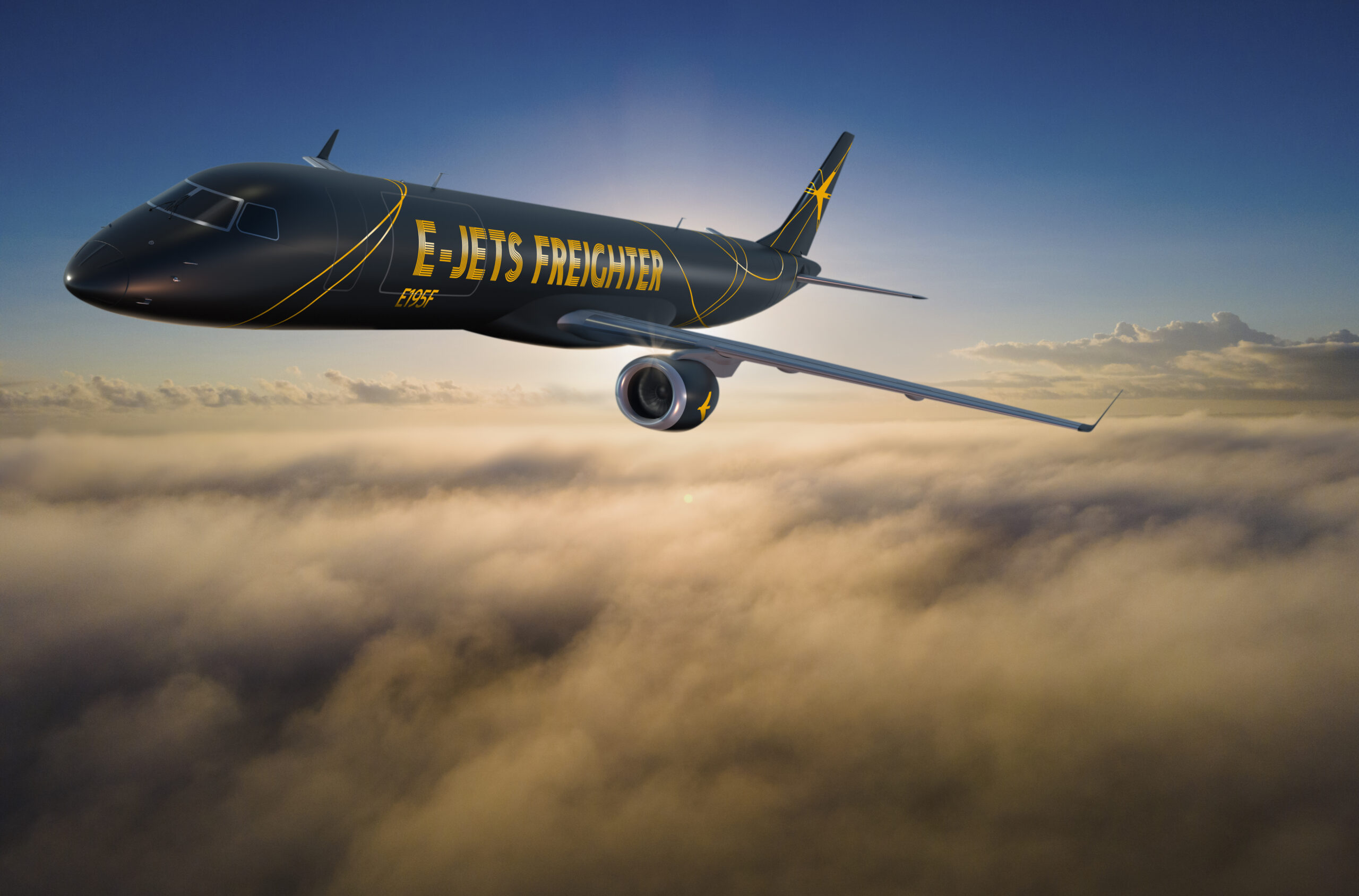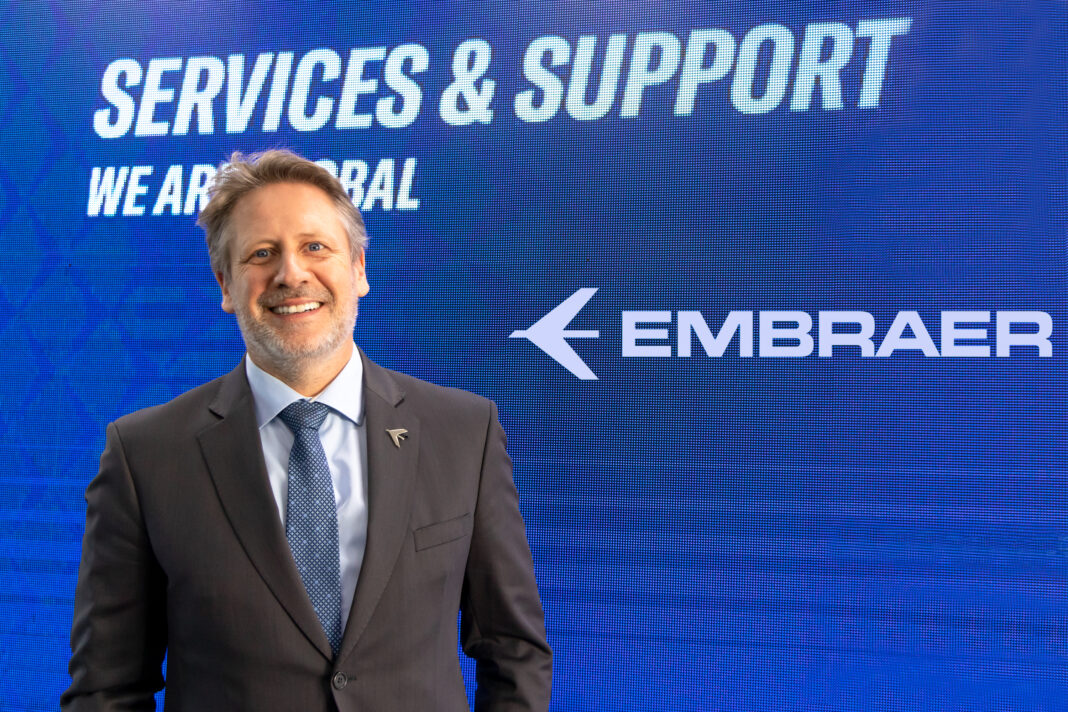The freighter market has seen an incredible growth in the last years, and it’s no surprise that is has exploded because of the pandemic. Embraer saw the opportunity to enter the high-demand, high-profit cargo segment with its well-known regional product.
We sat at FIDAE 2022 with Johann Bordais, President & CEO of Embraer Services & Support, and we chat about the Embraer E190/E195 P2F freighter conversion program or, as I repeatedly and mistakenly call them during the interview, the E-Freighters.
Aviacionline: In the aftermath of the pandemic, we saw the explosion of ecommerce. And within that explosion one of the key factors is same day delivery. Therefore, the last mile or leg of the whole logistics chain needed to be accelerated, and this is where the P2F conversions are aiming to enter, right?
Johann Bordais: Yes, we just made that decision. It’s a recent decision where we felt that it was the right moment to go and launch the 195 190 E1F as a freighter. I think it’s just natural.
The pandemic accelerated what we’ve seen over the last few years. And that was kind of, the tipping point where ok, this the right moment. If you think about it, in China, five years ago the E-commerce was representing 10% and now it’s just a big boom and going to 27%.
That’s what it is post pandemic and we’ve seen exactly happening this in the whole region and in the world. There’s a new generation. It’s the thing of, you know Immediatism. I don’t know some like this where basically we want the next day delivery next day, the standard the velocity, I mean the speed that we deliver those parcels is that last mile right?
And then we’ve seen this. We’ve seen that Amazon has been really spreading all the warehouses to get closer where the people are. It’s not just the big hubs anymore, and that’s the key word: “decentralization”.
I mean it’s happening right now, and this decentralization is really creating a new service. It’s not the old model of distribution for business. It’s the E commerce but also, it’s more than that, and the fact that now the Home Office has also contributed to this, because people are just going in the countryside more, so you need to reach out to them.
You don’t want to just stick to the big city you want go outside it and that’s exactly what we’ve seen where the frequency and the standard. As you said next day, or same day delivery is asking for a new way of transportation and air freight must go for the capillarity.
That’s what we’ve seen: now is the right time for cargo, and that’s what we create what we call the crossover jet for the cargo because it created a niche, not just between the ATR 72 and the A 319, or the 737.
A: You see that, for instance, we have the Cessna Sky Courier just covering that part of the segment just to accelerate the whole chain. You mentioned Amazon, right? Is that the market that this project is intending to? I mean, the decentralization of the logistics in the US or Europe.
JB: That’s not the only one. Our target is really the whole cargo airline with the complementary cargo activity that has been growing over the last couple of years because we have seen that with a couple of customers.
We brought a solution for our customer Azul, a very quick one where you could just transform the passenger’s area without a full conversion, but just few seats so you can just put some package converter cabin.
That was the immediate response that we give to the market, but we felt that Azul and other customers wanted more. That was not enough. They wanted a full cargo conversion and a real one, not the quick change, they wanted the real one where you have the AMS system change, the whole infrastructure, the avionics where you can really load right the content. A real freighter. So that’s up to twenty tons.

A: One of the issues that the pandemic showed in the commercial market is the dependency of belly cargo. Once the passenger flights were gone, belly cargo was gone as well. And the other main topic was that when demand grew there was no capacity to respond accordingly, thus increasing the price of the merchandise transported. These were the first years that cargo companies made significant profit.
Besides that, one of the main factors of the recovery after the pandemic or in this stage was the regional flights. Here’s the question: Do you think these Embraer P2F Freighter conversions are going to cover that market that belly cargo left and is still recovering? Will they be able to replace it?
JB: That’s exactly what happened with the belly cargo, and it just vanished. Yes, just right away. We still had the long-haul cargo because that relied on the widebody, but the narrowbody was deeply affected.
And then when we had the opposite, right after when we recovered the activity just starting to go and we have all the backlogs. And that’s what we have seen the number of parts that’s been keeping on the ground because Captain had to decide right there and you have bunch of parts that are just sitting, and pallets sitting on the ground, it’s just been terrible.
Like you said, less offer more demand and the price has been going up, so it is really once again the right moment for us to enter this market on the crossover on this up to twenty tons we see a demand of about seven hundred Embraer Freighter aircraft. That should be just filling it up with these new markets.
We want to be conservatives because you know honestly, we’re rookies when it comes to being part of the freighter segment, but we also believe that you know we can get about 20% of it. And I think it’s conservative. I think we can get way more than this, and one of the reasons is because it’s the right timing for the E-jet, we are at the 15 to 20 years mark where you know we have 700 E190 and E195 flying around the world and that are getting to that age where yo need to decide what do with them.
And that’s exactly the beauty of our decision. Well, you’re going to be extending the life cycle, and that’s what exactly what we’ve been seeing on the other platforms that go from airliner to freighter. So definitely this is the right moment for us to do this and absolutely no doubt that the E-jet is the airplane that will just cope with this regional increase.
And it’s amazing because our fleet was the first one to get back on service during the pandemic. So, we had the belly cargo which is great on a regional basis. But not enough, and that’s exactly what the E-jet will be doing.
A: One of the main vectors is going to be fleet renewal. We have companies that operate in 727 cargo or 737 300. For those companies, for those carriers, a 727 or a 737 is a bit too much and an expensive type to operate, but an Embraer E190 P2F Freighter is going to be enough.
JB: I think it will be enough. It’s really between the ATR 72 to the 737. I know that Boeing will probably offer -700 and -800 to replace those -300F, but not necessarily, you know. The E-jet is the most effective, the most reliable jet in its category. So, it’s we have the product on the airline: transform it into a cargo and it’s already there.
A: You are expecting to start deliveries on 2024. Boeing is getting an important number of conversion orders. Do you see an opportunity in all that backlog that they are going to accrue well for you to get into it with the P2F?
JB: Well, we want to make it a success. We believe that’s that the priority right now. We start with a production line in Brazil inside this complex [Sao José dos Campos, SP] because you have the synergy with the current hybrid production line that we have, where we still make E1 and E2’s, you have access to the engineering, to all the infrastructure, the footprint optimization that we can make.
We have the know-how; we have the people over there. So, this is why we want to make sure that the first line will be inside this complex. We’re looking at a production capacity of probably 12 airplanes per year. And then you are right, we’ll see the success of the other program if that makes sense. We’ll analyze having a line in the US or even in China, but that’s not for the moment. That’s not the case.
A: Talking about successes, this is about the Embraer E190 and E195 Freighter, but are you considering the E175?
JB: For the moment we’re thinking of the Embraer E190 and E195 Freighter, but if it makes sense afterwards, we’ll see. The economics just really makes sense so well, and it’s been confirmed by the few customers that we’ve been in contact with and hopefully we’ll be able to announce our launch customer by the end of 2022.
We have a few contacts and right now we’re in the phase of development and then we’ll have a test period, aiming for the certification. So, all this should be folding out on the second semester. And then we’ll be able to talk again and give you some update on this program.







